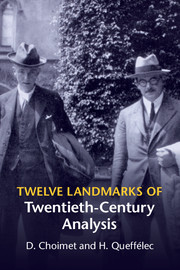Book contents
- Frontmatter
- Dedication
- Contents
- Foreword
- Preface
- 1 The Littlewood Tauberian theorem
- 2 The Wiener Tauberian theorem
- 3 The Newman Tauberian theorem
- 4 Generic properties of derivative functions
- 5 Probability theory and existence theorems
- 6 The Hausdorff–Banach–Tarski paradoxes
- 7 Riemann's “other” function
- 8 Partitio numerorum
- 9 The approximate functional equation of the function θ0
- 10 The Littlewood conjecture
- 11 Banach algebras
- 12 The Carleson corona theorem
- 13 The problem of complementation in Banach spaces
- 14 Hints for solutions
- References
- Notations
- Index
Foreword
Published online by Cambridge University Press: 05 August 2015
- Frontmatter
- Dedication
- Contents
- Foreword
- Preface
- 1 The Littlewood Tauberian theorem
- 2 The Wiener Tauberian theorem
- 3 The Newman Tauberian theorem
- 4 Generic properties of derivative functions
- 5 Probability theory and existence theorems
- 6 The Hausdorff–Banach–Tarski paradoxes
- 7 Riemann's “other” function
- 8 Partitio numerorum
- 9 The approximate functional equation of the function θ0
- 10 The Littlewood conjecture
- 11 Banach algebras
- 12 The Carleson corona theorem
- 13 The problem of complementation in Banach spaces
- 14 Hints for solutions
- References
- Notations
- Index
Summary
Analysis… the word is dangerous. Mention it at a dinner party, and depending on your guests, it will bring to mind lab coats and test tubes, or couches and psychoanalysts, or perhaps again those experts that unveil the subtleties of an economical or political crisis. Clarify that you are referring to mathematical analysis and the image will change: former students will then recall memories of derivatives and integrals, and no doubt remind you that it was much easier to calculate the former than the latter… But perhaps one might ask you: Mathematical analysis, no doubt it's all very nice, but whatapos;s its point? In fact, what are you analysing?
The book of Denis Choimet and Hervé Queffélec provides brilliant and profound answers to these questions in a most agreeable manner.We follow the evolution of analysis throughout the twentieth century, from the founding fathers Hardy and Littlewood, to the creators of spaces Wiener and Banach and up through contemporaries such as Lennart Carleson. The historical perspective helps us understand the motivation behind the problems, and the naturalness of their solutions. Moreover, analysis is shown clearly for what it is: a discipline situated in the heart of mathematics, indissolubly linked to arithmetic and number theory, to combinatorics, to probability theory, to logic, to geometry… Its objective is hence to serve mathematics and consequently all of the sciences, and thereby each and every one of us.
I have the pleasure of knowing Denis and Hervé. Hence I can assert that their knowledge of analysis can be qualified as encyclopaedic. However, they were not attempting to write an encyclopaedia, and the roots of their work can be found more in Cambridge than in Paris, Warsaw or Moscow. This wise approach allowed them to explore multiple directions right up to the most recent results, while maintaining the profound unity of a very reasonably formatted book, providing constant encouragement to the reader.
- Type
- Chapter
- Information
- Twelve Landmarks of Twentieth-Century Analysis , pp. xi - xiiPublisher: Cambridge University PressPrint publication year: 2015



